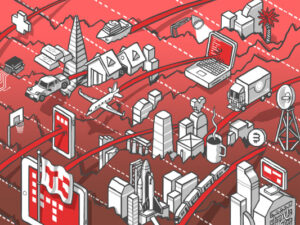As per estimates, 97% of all the large companies around the world are now leveraging analytics with over 100 million users across the globe
Maps and spatial analytics are capable of providing a completely new context that is otherwise impossible with mere tables and charts
By merging the company base with sophisticated GIS software, businesses can better visualise the relationship between customers, employees and suppliers, all the while improving upon their profit margins and efficiency across the organisation.

There has been a growing realisation that by combining spatial software data or Geographical Information Systems (GIS) with Business Intelligence (BI), organisations today can improve upon their productivity and increase cost efficiency like never before. As we all know, business analytics today has become quite common in both public as well as private sector organisations – in fact, as per estimates, 97% of all the large companies around the world are now leveraging analytics with over 100 million users across the globe.
Adding the geographic component to business data and then mapping it, can help organisations in dramatically enhancing their insights into tabular data. Maps and spatial analytics are capable of providing a completely new context that is otherwise impossible with mere tables and charts. The new context can help users discover new insights almost immediately and be able to communicate more effectively using maps as a common tongue.
By merging the company base with sophisticated GIS software, businesses can better visualise the relationship between customers, employees and suppliers, all the while improving upon their profit margins and efficiency across the organisation.
Benefits of integration of Spatial Software Applications with Business Intelligence include:
- Getting a cohesive understanding of the information needs of an organisation, so as to be able to identify and prioritise crucial initiatives.
- Monitoring of key business processes
- Access to operational information at a glance
- Organization of reports and models that offer a business view of data
- Enhancement of analytical and decision-making capacity
- Managing the performance of the organisation.
Other functional areas that spatial software applications can be leveraged to achieve greater functionality and integration are:
- Customer Relationship Management: Spatial software applications can be used for the analysis of customer shopping frequency, and then adjust operating hours on the basis of the shopping times. Apart from this, alteration of locational pricing and inventory needs, identification of beneficial locations for the opening of additional storefronts and even creation of targeted advertising campaigns are some of the benefits that can be affronted by spatial relationships.
- Data Accuracy and System Management: One of the chief benefits of GIS is that it allows users to be able to view and analyse data even where no other association might be available. One can take the example of utility management wherein once established, GIS systems can serve as a pivotal link for meeting the ongoing data maintenance requirements, lending support to various other data analysis activities as well as providing an interface with other applications and systems.
- Marketing: A wide variety of organisations have leveraged spatial software for their marketing intelligence and analysis needs. In fact, it can be utilised for marketing a broad spectrum of activities from internal, local to even national market analysis.
Spatial software can also be used for the customisation of regional advertising and promotions on the basis of regional demographics. Apart from this, agencies can also utilise it for the launch of new products on a national scale, via target marketing, custom mailings, advertising, and media selection.
- Inventory Management and Efficient Delivery: When combined with business intelligence, spatial software can help in addressing inventory, logistics and transportation issues. Optimization of delivery routes can help in charting efficient delivery paths for multiple deliveries. Since the software can support both modelling activities and displaying results in a user-friendly manner, it can support better decision making that helps in operational efficiency via better inventory management as well as optimised logistics.
Spatial software applications can have a profound impact on business and industry transforming the way organisations leverage geographic knowledge for greater functionality. Enhancing business intelligence capabilities of your organisation, by investing in GIS can lead to a significant increase in your profits and a remarkable decrease in your expenditures as the efficiency and effectiveness of your business plan is consequently improved.










